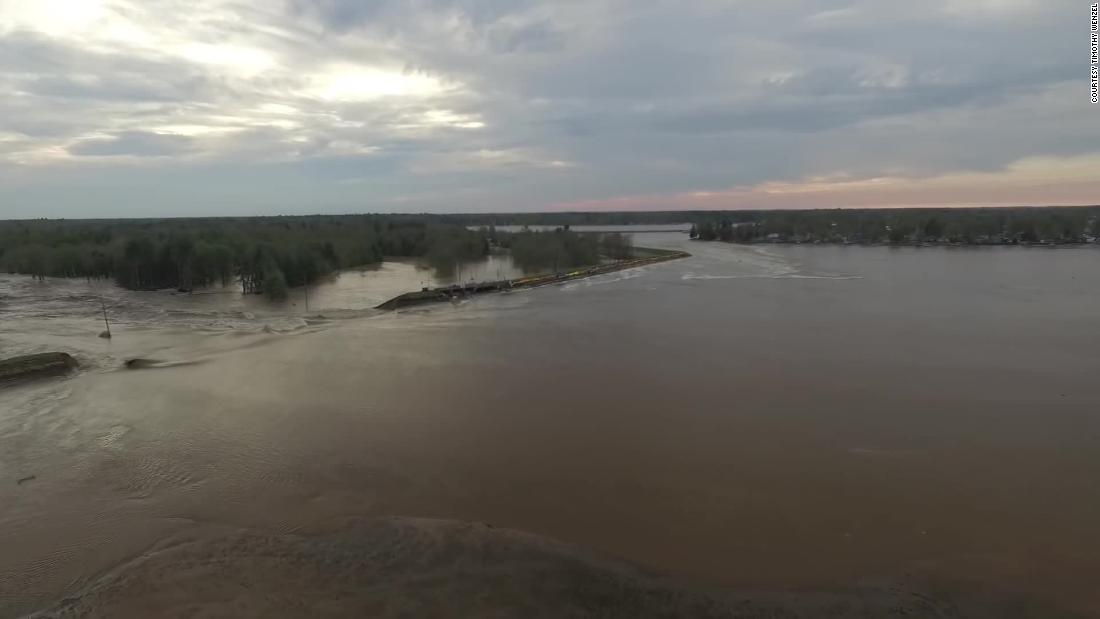[ad_1]

Although federal regulators repeatedly warned about the dam’s inability to handle a large flood, it took years for federal authorities to crack down on the dam’s operator after more than 13 years of cajoling them to abide by the terms of their license.
Documents posted by FERC show that inspectors warned in January 1999 that the operator needed to increase the capacity of the dam’s spillways. Spillways are structures that allow for floodwaters to safely escape downstream and prevent incidents such as the massive flood that inundated Midland, Michigan, this week from occurring.
In a January 4, 1999, letter to Wolverine Power Corporation — the company that operated the dam at the time — Donald Lesniak, then the regional director of FERC’s office in Chicago, told the company’s then-general manager that “modifications to increase spillway capacities at all your projects remain the primary concern.”
FERC directed Boyce Hydro, the owner of the dam, to establish an independent investigation team to analyze the cause of the overtop of the Sanford Dam, a separate barrier in the area, according to Celeste Miller, a FERC spokeswoman.
“FERC continues to follow the reports on the situation at the Edenville and Sanford Dams. Our primary concern is the safety of Michigan residents, and we urge them all to continue heeding evacuation guidance by local emergency management agencies,” said Neil Chatterjee, FERC’s chairman, in a written statement. “When it is appropriate and safe to do so, FERC will send a staff engineer to the site to assist with the investigation. The Commission pledges to work closely with state officials and coordinate our investigatory efforts wherever possible.”
Boyce Hydro took over operations of the dam in 2004 and, according to documents filed by FERC officials, did not come up with “adequate” plans for increasing spillway capacity in the ensuing 13 years, eventually leading to that company having its license revoked and a local task force given a preliminary permit to operate the dam. That local task force does not expect to fully take over dam operations until 2022.
That proved true on Tuesday when the dam failed after intense rains in the mid-Michigan region, sending floodwater into Midland’s downtown. Photos showed floodwaters reaching the tops of stop signs and the roof of the city’s farmer’s market. Whitmer, a Democrat, warned the city’s downtown could be left under 9 feet of water by the time floodwaters peaked.
Hill wrote in the 2017 compliance order that Boyce Hydro had ignored multiple directives from regional FERC officials to increase the dam’s capacity to handle large-scale floods. The dam could only handle 50% of a Probable Maximum Flood, she wrote, and federal regulations require dams to be able to handle 100% of a Probable Maximum Flood, otherwise known as “the flood that may be expected from the most severe combination of critical meteorological and hydrologic conditions” in a given area, according to FERC.
The compliance order followed more than a decade of FERC warnings to Boyce Hydro about the dam’s inadequacy.
According to the compliance order, Boyce Hydro and FERC met in 2005, 2006, 2007, 2008 and 2009 to discuss the need to increase the dam’s capacity. In 2009, the company was given a four-year extension to construct new spillways that would get it in compliance with federal regulations.
However, that work was “never completed,” Hill wrote in the order. FERC, at that point, gave Boyce yet another extension to construct spillways that still have not been built.
It wasn’t until September 2018 that the federal government finally punished Boyce Hydro for repeatedly ignoring their directives.
“Boyce Hydro’s license includes terms and conditions concerning dam safety, property rights, water quality, public recreation and safety, and other areas of public concern,” the order revoking the license stated. “Boyce Hydro has a long history of non-compliance with those terms and conditions and with related provisions in the (Federal Power Act) and Commission regulations and orders.”
CNN attempted to call a phone number listed for Boyce Hydro for comment, but the call went unanswered and no voicemail system had been set up for the number.
Michael Swiger, a Washington, DC-based attorney representing the company, wrote that Boyce operated under “serious financial constraints” that kept it from funding the necessary construction of spillways. Swiger said the company had found the funding to do the construction work, but the federal government was not allowing them to move forward due in part to a lack of a construction timeline.
Swiger issued a warning that revoking the company’s license would ultimately end up decreasing public safety.
“In sum, although (Boyce Hydro) has not fully met the requirements of the Compliance Order, it has certainly done everything it can reasonably do to meet those requirements given its limited resources and the lack of reasonable time to comply,” Swiger wrote. “Moreover, as discussed below, license revocation would be self-defeating since it would ensure that the dam’s spillway capacity is never increased.”
Boyce Hydro is in the process of transferring ownership of the Edenville Dam to the Four Lakes Task Force, an entity set up by Midland and Gladwin counties to operate four lakes in the area created by the dams. In January, the task force signed a purchase to acquire the Edenville, Sanford, Secord and Smallwood dams and the lakes they create, but the titles for the dams have not yet been transferred.
The task force did not immediately respond to CNN’s request for comment on any work it has done to improve the dam.
The task force notes on its website that it made the purchase because “the repairs and improvements to the dams are a higher burden than revenue from electrical generation alone can support.”
“The dams are considered safe and fit for operation in the short-term,” the website reads.
[ad_2]
Source link

